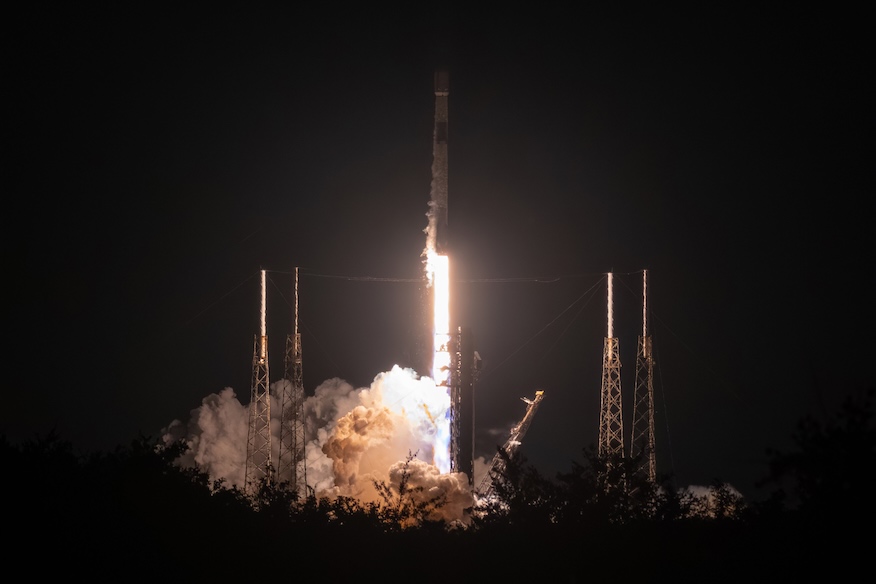SpaceX successfully launched its latest batch of Starlink satellites early Tuesday morning, June 3, 2025. This mission, designated Starlink 12-19, lifted off from Space Launch Complex 40 (SLC-40) at Cape Canaveral Space Force Station in Florida at 12:43 a.m. EDT (0443 UTC).
The launch proceeded smoothly after an earlier attempt on Monday was scrubbed. This successful flight further expands SpaceX’s massive Starlink constellation, aimed at providing global internet coverage.
Overcoming Weather and Space Conditions
The path to launch involved navigating both terrestrial and extraterrestrial weather phenomena.
Terrestrial Weather Challenges
Meteorologists from the 45th Weather Squadron had previously forecast a 65 percent chance of favorable weather for the Monday launch attempt. They noted a lingering frontal boundary across Northeast Florida, bringing increased moisture. While most daytime thunderstorms were expected to dissipate by the evening, some showers and high-altitude anvil clouds were predicted to persist past midnight. The primary concerns for the initial launch window were cumulus clouds, surface electric fields, and lingering anvil clouds.
Geomagnetic Storm Activity
Beyond Earth’s atmosphere, potential impacts from a Coronal Mass Ejection (CME), which erupted from the Sun on the preceding Friday, were also being monitored. This phenomenon, known as a geomagnetic storm, continued to affect Earth’s magnetic field.
The National Oceanic and Atmospheric Administration’s (NOAA) Space Weather Prediction Center (SWPC) in Boulder, Colorado, continuously tracked and evaluated the storm. As of its most recent update before the Tuesday launch, the storm was rated as ‘G3 Strong’ on the SWPC’s scale (which tops out at G5). The agency had warned of a “possible, slight risk of various satellite operations’ effects” due to the ongoing space weather event.
The Launch and Booster Landing
Despite the complex conditions, the mission proceeded efficiently, showcasing SpaceX’s reusability prowess.
— NOAA Space Weather Prediction Center (@NWSSWPC) June 2, 2025
Falcon 9’s Rapid Turnaround
The previous launch scrub in the overnight hours from Sunday into Monday did not appear to be caused by either terrestrial weather or space weather conditions. Had SpaceX been able to launch its Falcon 9 rocket during that earlier window, it would have marked the second-fastest turnaround time for SLC-40 to date. This suggests that the launch teams likely needed more time to finalize all preparations for that specific slot.
A Veteran Booster’s 21st Flight
For this mission, SpaceX utilized its veteran Falcon 9 first stage booster 1071. This particular booster has an impressive flight heritage, completing its 21st successful flight with this launch. Its prior missions include significant endeavors such as NASA’s Crew-5 astronaut transport, the GPS III Space Vehicle 06 launch, and the NG-20 mission carrying a Cygnus spacecraft for Northrop Grumman.
Precision Landing
A little over eight minutes after liftoff, the Falcon 9 first stage booster 1071 executed a precise landing. It touched down flawlessly on the droneship ‘Just Read the Instructions,’ which was stationed in the Atlantic Ocean. This marked the 123rd successful landing for this particular droneship and the 456th booster landing for SpaceX to date, a testament to their reusable rocket technology.
Starlink Payload: Expanding Global Connectivity
The mission’s primary objective was to deploy more satellites for the Starlink constellation.
23 New Satellites Deployed
Onboard this first Falcon 9 launch of June were 23 Starlink satellites. These satellites will contribute to the ever-growing network designed to provide high-speed, low-latency internet connectivity around the globe.
Direct-to-Cell Capabilities
Notably, 13 of these 23 satellites possess direct-to-cell capabilities. This advanced technology allows Starlink satellites to connect directly to standard mobile phones, potentially eliminating the need for traditional cell towers in remote or underserved areas. To date, SpaceX has now launched a total of 635 Starlink satellites equipped with direct-to-cell technology, significantly expanding the reach of cellular communication.








